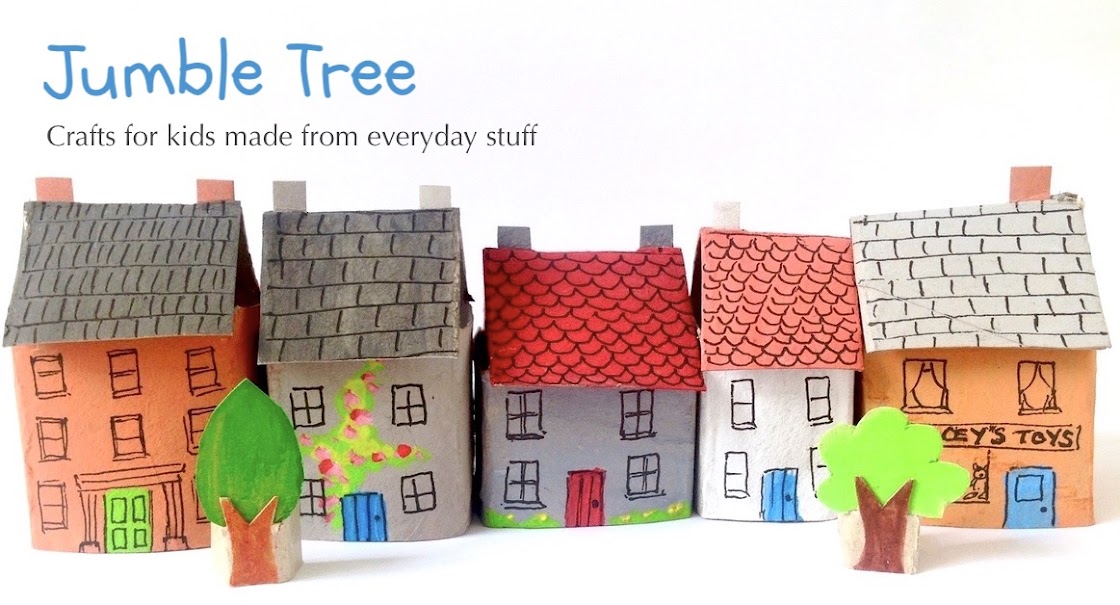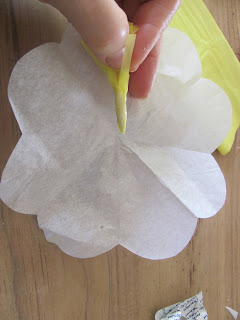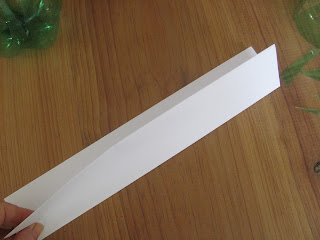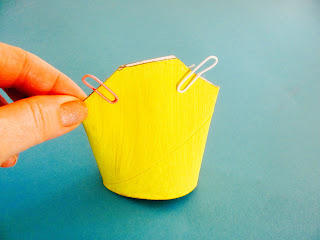5.6.18
Egg carton sheep
These sheep are the first project in 'Make Your Own Farm Animals' and they're really quick to do - a few egg boxes, cotton wool and a black felt tip, and you'll have your own flock before you know it!
You will need:
Egg carton
Pencil
Scissors
Cotton wool
Glue
Black felt tip pen (or a Sharpie if you're happy to use a permanent pen)
1. Cut out an egg cup, roughly first, then neaten up the edge. Turn it upside down and draw a cross on top with a pencil (see below), and continue the lines down the sides of your egg cup.
This should give you four well spaces legs.
2. Use a black felt tip pen or a Sharpie to colour in the bottom part of the legs, so they are more chunky.
3. With your scissors, snip up the sides of each leg (8 snips) - don't worry if you snip too far, you'll soon be covering the top part with cotton wool.
4. Snip the card HALFWAY BETWEEN each leg too (4 snips)
5. Push all the flaps of card, between the legs, under your sheep, leaving the four legs down.
6. Cover the top of the egg cup with a thin layer of glue. Tease out a small piece of cotton wool with your fingers and stick it on top of your sheep. A small amount of cotton wool looks best.
7. Draw a head on either the egg carton lid or some spare cereal box card. Keep the shape simple so it's easier to cut out.
8. Use the black pen to draw two circles where you would like the eyes to go and colour-in around the circles. Add a black dot in the eye if you want. Glue in place.
9. For a lying down sheep, cut a shallower egg cup from your carton and cover the whole thing with cotton wool. Glue on the head.
TIP: A white correction pen (like Tipp-Ex) is handy for eyes if you want to add them after colouring-in the head, or you want to make a sleeping sheep with closed eyes.
Many more animal projects like this in my book, 'Make Your Own Farm Animals'
21.5.18
Pretty tissue Peonies
Peonies are a real head-turner at this time of year, with their showy blooms in all kinds of colours. I saw the most beautiful tree peony the other day with enormous pink flowers, which sort of got me thinking about this project. And of course peonies were centre stage at the royal wedding.
The great thing is, because of their naturally ruffled, billowy shape, they're really easy to make.
You will need:
Sheet of yellow tissue paper
3 sheets of coloured tissue paper for the flower
Scissors
Craft glue
Elastic band
Pipe cleaner (optional)
1. For the petals, we used a white sheet of tissue paper and two pink sheets.
Fold one sheet a few times, so you have a few layers and cut a square, about 16cm by 16cm (or bigger if you want).
The shape of our sheet meant it was easy to fold into a square shape that was roughly the size we wanted, so all we had to do was just cut along the creases.
Repeat with the other two coloured sheets, so you end up with lots of tissue squares.
2. Take one square and fold it in half, then fold it again, into a smaller square. With the pointy end (that's the middle of the square) nearest you, fold into a triangle and cut the other wider end into a curved shape, so it looks a bit like an ice-cream!
I've drawn it on so you can see more clearly. This might be a good thing to do for younger makers too. It doesn't matter if the shape you cut varies from piece to piece - having different petal shapes will add to the overall effect.
4. For the centre of the flower, fold the yellow tissue paper sheet over a few times and cut about a 6cm strip.
5. Hold the folded tissue firmly, and cut a fringe along an open side - cut about halfway down.
6. Roll the strip tightly at the bottom, and put a small blob of glue at the end. Finish rolling, and squeeze where the glue is, so it sticks the tissue paper layers together.
7. Brush some more glue all around the bottom part of your yellow centre, then put the gluey end in the middle of one of the petal pieces and simply gather up, and press around the yellow centre. Give it a good squeeze at the bottom.
You can either keep brushing glue around the bottom before each petal piece (can get quite sticky), or just keep gathering the petals around the centre without glue, keep a firm grip on the bottom, and then, with adult help, wrap a small elastic band around a few times, to hold the petals in place.
Give your finished flower a bit of a scrunch, before fluffing it out a bit with your fingers.
You could also wrap the end of a pipe cleaner around the bottom of the flower a few times, to secure it, so it's easier to display in a vase, or attach as a decoration.
15.5.18
DIY Dandelions and Daisies
Everything in the garden looks good in May I think, even the weeds have a kind of charm, and I have a soft spot for these bursts of yellow and white that pepper the grass.
Know it's not everyone's favourite, but I love a sunny yellow flower.
These paper daisies and dandelions are easy to make and can be used in lots of different ways - to stick on cards or pictures, or as decorations.
You will need:
Plain white paper
Yellow paper (optional)
Scissors
Glue stick
Craft glue
Yellow tissue paper
1. For the little daisies, fold an A4 sheet of plain paper in half, lengthways, then fold it again lengthways two more times.
2. Cut thin strips by cutting across the folded paper, then unfurl your strips and snip into pieces by cutting on the creases.
3. Rub glue stick in the middle of a petal piece and stick another one at right-angles to it, to make a cross. Rub more glue in the middle and attach another two petal strands, to fill the gaps.
We found the best way was to assemble a daisy on a finger tip! The first rub of glue seemed to fix the petal strip steady on the tip, making it easier to add the other pieces, but use whatever method you find best.
4. Use a hole punch to punch out small yellow circles - if you don't have yellow paper, colour in some plain paper.
5. Rub glue in the centre again, wet your finger to help pick up the little yellow circle, and glue it down.
6. For the dandelions, fold a sheet of tissue paper a few times so it's easier to cut across. Cut a few 4/5cm strips.
7. Cut a fringe along an open end of one of the pieces (keep the cuts close together). Make the cuts about 2cm long (no more than halfway down your strip)
8. Open up the strip and dab some glue along it at intervals, just under the fringe, then fold the strip in half.
Best not to use a glue stick like we did... because the tissue paper is easy to rip - better to use a small amount of glue on a brush.
9. Dab more glue along the length of this shorter strip, again just under the fringe, and tightly roll your strip. It can be fiddly to start off, but once you get going you can hopefully roll it between your finger and thumb, and remember to press tightly just under the fringe where the glue is. Brush some glue on the end of the strip and tightly roll the last bit.
10. Puff out the dandelion with your fingers, trim the centre if you want, to make it flatter. We cut the stalk bit off so we could stick them on a picture.
17.4.18
Paper plate hen
This hen was inspired by a paper plate challenge on Instagram and it's really simple to do. You could paint yours any colour you want, but we went for speckled, which is so quick!
28.3.18
Brian the Lion
What can I say about Brian? He was the first cardboard tube animal I made with my daughter, and I've always had a soft spot for him. He really kicked off the whole Zoo and Farm craft journey, so I couldn't be happier he now has his very own picture book.
'Brian the Lion goes into Space' is a colourful, wacky space adventure, with some fun twists and turns along the way.. There are lots of little beardy blue gnomes, rainbow food, oh, and a friendly dragon called Norris..
 |
| The gnomes want to read Brian's new book! |
The book combines storytelling and craft, as Brian's world is made out of cardboard (of course)..
All the picture scenes in the book are created from ordinary packaging like egg cartons, tubes and cereal boxes. Plenty of familiar things for kids to spot, and hopefully it'll inspire some making too! The book is available on Amazon.
I have shared a Brian project before, quite a long time ago now.. so, in honour of his first book, I've updated it here.
You will need:
Toilet paper tube (or kitchen paper roll)
Cereal box card
A cup/beaker and egg cup/spice jar or similar, to draw around
Craft glue
Scissors
Ruler
Pencil
Yellow and Brown paint (mix a little red with yellow and a dab of blue)
Black felt-tip or gel pen
Paper clips
1. Paint the tube and some cereal box card yellow (enough for the face, tail and paws) and paint another piece of card brown (enough for the mane).
Painting first can speed up the making (if your mini maker doesn't mind a short wait at the start..), but in MYOZ we got stuck in straight away, cutting and gluing the body first, and then painting, which is fine too!
2. When the paint is dry, cut the tube so it's about 8cm high. An easy way to do this is to use a ruler to mark 8cm on the side, then squeeze the tube flat, near the mark, and cut across, cutting through the mark (younger ones might need some help cutting through the double card).
3. Squeeze the top part of your tube together again, and give Brian some shoulders by snipping little triangles off the sides. Don't take too much off.
4. Brush some glue all along the inside edges of the end you've just cut. Don't overload with glue or it will ooze out everywhere when you squeeze the glued sides together.
Use two paper clips to keep the sides together while the glue dries.
5. Time to make Brian's head. On the brown card, use a pencil to draw around a big circle, like the top of a cup or beaker - and draw around a small circle, like an egg cup or spice jar on the yellow card. Carefully cut these out. (slowly turn the card circle towards you as you cut, rather than moving or turning the scissors.)
6. Place the smaller yellow circle in the middle of the brown one, and when you're happy, lightly draw around it and put aside.
(*see tip below for younger makers)
7. For his mane, the best and easiest way to keep it even, is to cut up to the pencil line and then make a cut opposite the one you've just made.
Halfway between them, make another cut on both sides.
Keep cutting halfway between all your cuts until you feel his mane is full enough. (Don't worry if you cut over the pencil line, this will be covered up by the face in a moment)
8. Draw on Brian's face with a black pen. Brush a thin layer of glue on the back of the face and place it in the pencil circle on the mane. Make sure you don't use too much glue or it will squidge out the sides!
9. From the spare yellow card, cut a thin strip for a tail and cut out two paws. (You could make a paw template first, then draw around it to keep your paws the same size).
We cut out a little brown piece to glue onto the end of the tail too, but leave it plain if you want, or colour in the end with a pen. Add some claws to the paws.
10. Glue the paws on, again, just use a little glue, and make sure they don't hang over the edge of the tube. Dab some glue on the plain end of the tail strip (painted side) and stick it at the back, inside the tube (you can bend it into place when the glue has dried).
Finally, remove the paper clips and glue on the head.
Leave Brian lying on his back while the glue dries.
When Brian's ready, bend the tail back, into place, and fluff up his mighty mane!
* TIP: For younger makers, leave out the mane cutting and draw on paws instead of cutting them out.
There's also a tutorial to make the little blue gnomes Brian meets on his adventure in space. Using corks and cotton wool! Full step-by-step instructions here.
Subscribe to:
Posts (Atom)










































































